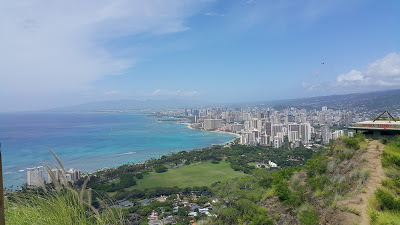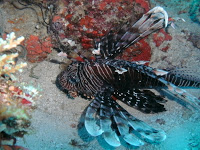My Maldivian holiday saw me studying, relaxing, reading, eating, sleeping, diving and repeating. It was my best holiday so far.
The studying was for my diving license. I needed to read a couple of chapters of the diving manual but me being the nerd that I am, read the whole book. Safety first, I like to be prepared!
Over three and half days, we covered theoretical and practical elements of diving. The practical saw us in the Indian Ocean learning and doing (or as our instructor says ‘copy and paste’ him) the various diving skills while trying not to be too distracted by beautiful fish, rays, turtles and the occasional small shark. I even saw a
yellow margin moray eel and three
nudibranches hiding in the coral.
One occasion, when I wasn’t distracted, I managed to breathe a lung full of that ocean.
It all started with a buddy ascent. You’re meant to have your regulator (this is the bit that helps you breathe underwater) out of your mouth, catch your buddy, put their back-up regulator in your mouth, blow the water out of it, continue to breathe and slowly ascend while holding onto each other.
Even as I write this, I’m laughing because it is so simple and I did something so silly.
It was all going well when I reached my instructor, put his spare regulator in my mouth, thought I cleared it and breathed. Not good – this is when I confirmed that it is not possible to breathe the ocean no matter how clear the water is.
It’s amazing how many coherent thoughts and actions are possible in a split second:
- I looked up and realised the top of the water was well above me
- I looked at my instructor and realised he won’t let me drown for a number of reasons including that it just wouldn’t look good for the dive centre or their insurance policy
- My instructor then turned the regulator up the right way and reminded me the alternate way to clear it
- I nodded that I understood
- I put it back in my mouth, the right way up, cleared and tried breathing again
- I floated there for a few seconds to get my breathing back under control and ascended.
This taught me:
- Always check which way the regulator is before putting it in my mouth
- The lungs can hold a lot more oxygen in reserve than what I realised
- Trusting your dive buddy is incredibly important – admittedly, this kind of thing wouldn’t typically need to be used, but it’s nice to know that they’ll know what to do if you’re potentially in a situation where you could panic
- Thoughts and actions can be incredibly quick when time seems to stop
- It’s good to make mistakes while learning so I’ve learnt my lesson in a safe environment
My biggest achievement over my seven dives was reaching a depth of over 30 metres and having my weights removed. Seems like no big deal but to have neutral buoyancy and not have to kick to keep myself off the ocean floor but to be floating there instead with no effort on my part (aside from breathing properly) was brilliant. It is such a feeling of freedom and weightlessness and quite cool to be in a three dimensional space like this.
This is one of the advantages to diving with the instructor as he added and removed weights as required.
The down side was nearer the end of each of my dives, where with the weight of the tank reduced, I’m too light to stay in the safety zone by myself so I’m experimenting with ways to fix this. Unfortunately for now though, I need to dive with the extra weight to start and have to work to keep off the bottom instead.
After discovering the underwater world and using a camera for one of the dives, I’ve just discovered two new pastimes and conveniently, I can take them travelling. Both need work, particularly the photography given my targets keep moving faster than what I can focus!

I’ve also now eaten my last lobster. Not that I have ever had the opportunity to eat them that regularly. We had booked a lobster dinner for our anniversary evening. That day however, I saw two lobster in the wild hiding in their little underwater cave. While I know they weren’t the same lobsters, it’s not the point. I will continue to eat fish and yes, I realize this probably doesn’t make a lot of sense!
We stayed at
Medhufushi and I highly recommend it for anyone interested in diving or relaxing. It’s great for groups and couples (there were many honeymooners there, identified by the new wives still having immaculate fingernails). Probably not so good for families unless the children are outdoor types and know how to create their own fun and not so good for surfers either as there are only two breaks which don’t always ‘work’.
 |
| Water villas |
 |
| Sunset taken from near the dive centre |
Our last night was spent in the bar (not surprisingly) saying goodbye and sharing our diving experiences with some new friends to encourage them to also have a go.
The following morning, packing finished, breakfast eaten, back at the bar to wait for our sea plane to Malé, the capital city. We had decided to do a tour while waiting for our flight to Singapore later that evening.
Interestingly,
Malé and
Ap Lei Chou (an island in Hong Kong) have the highest population densities in the world.
Our guide was great and shared with us his experience living there as well as the interesting history of the Maldives. From the days of the Sultans to now, the country has been through quite a bit of change, not only political but also religious.
 |
| Hukuru Misikiiy – the Friday Mosque |
It was Ramadan and only one restaurant was open during the day, which kept their windows shut so those fasting wouldn’t see the diners. This time of year has had a fascination for me thanks to a former colleague and the leftover foods he’d bring into work each morning from the night before or even that day’s pre-dawn meal. The concept of fasting itself is interesting and those that work in restaurants or do physical work over this period humble me. A few people that we spoke to in the restaurants on Medhufushi mentioned the first three days are generally the hardest.
The Maldives import most things except fish and coconuts. The fishing is sustainable and no nets are used yet they manage to catch some massive fish using poles or hand reels. Impressive effort.
 |
| Preparing a yellow-fin tuna at the fish markets |
Our tour covered the fish and fruit markets, Hukuru Misikiiy (the Friday Mosque), built in 1658 and the Grand Friday Mosque, built in 1984 and can hold over 5,000 people and was donated by other Islamic countries, cemeteries dating back to the 1100s where the tombstones are made from carved coral, Sultan’s Park, built on the former Royal Palace grounds from the 1600s, Theemuge, the former Presidential Palace and Muliaage, the current Presidential Palace. No wonder I’m ready for another holiday.
I’m already missing the papaya.
Back to work on Monday and time to now research my next dive…
 |
| Medhufushi from the air |
* Thanks to The Choirboys for the title to this post – I’ve gone old school with this one!
Like this:
Like Loading...
Related
 I’ve also now eaten my last lobster. Not that I have ever had the opportunity to eat them that regularly. We had booked a lobster dinner for our anniversary evening. That day however, I saw two lobster in the wild hiding in their little underwater cave. While I know they weren’t the same lobsters, it’s not the point. I will continue to eat fish and yes, I realize this probably doesn’t make a lot of sense!
I’ve also now eaten my last lobster. Not that I have ever had the opportunity to eat them that regularly. We had booked a lobster dinner for our anniversary evening. That day however, I saw two lobster in the wild hiding in their little underwater cave. While I know they weren’t the same lobsters, it’s not the point. I will continue to eat fish and yes, I realize this probably doesn’t make a lot of sense!







3 thoughts on “Run to Paradise”
No more lobster? – what are your thoughts on crab??
Glad you had a good time. Cool photos
Niall
G'day, Alex and I are off to Fiji for a sort of dive holiday as of tomorrow..
Have fun in Fiji!
In regard to the crab – I'm still for them as long as they're sustainably farmed / caught. I can't make too many seafood sacrifices all at once and I've seen far more crabs in the wild than I ever have lobsters so I don't think they're having such a problem!
Comments are closed.